Chris & Allyson vs. California (2014)
Day Two: Golden Gate. Muir Woods. Haight-Ashbury. Lombard Street. The Punchline.
Jet lag is your friend on the West Coast. When you wake up at 7 a.m., your body will think it's 10 a.m. You get all the smug self-satisfaction of waking up early, with all the physiological benefits of sleeping in.
And on top of that, the early bird gets to experience popular tourist destinations before there's a line. This is crucial to vacationing the Chris White way, which is internationally recognized as the best way. I have personally recognized it as such on three different continents.
The point is, our first full day in California started at 7. At most of the hotels I choose, the concierge is a metal rack with at least one pamphlet for a water park. You're paying for a human concierge at the Palace, and he has to wear a necktie and everything. So why not get your money's worth? At his recommendation, we had breakfast at The Grove, a funky and casual restaurant a few blocks from the Palace. Some restaurants rely on one theme, but The Grove has two. Instead of support columns, there are "trees" wrapped in Christmas lights; and for some reason, the wall decorations have something to do with bus stations. In accordance with California law, I had a breakfast burrito. We then retrieved Bendy from the valet and began our exploration of San Francisco, by immediately leaving it.
The iconic symbol of San Francisco is the Golden Gate Bridge. Completed in 1937, it links the city to Marin County. It became truly famous in 1985, when Roger Moore fought Christopher Walken on one of its support cables. Its official color is International Orange, and people enjoy jumping off of it.
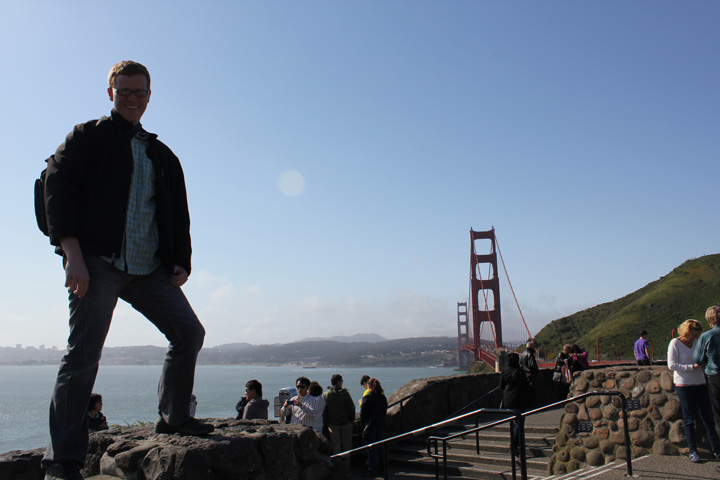
Open up your Golden Gate, California here we come.
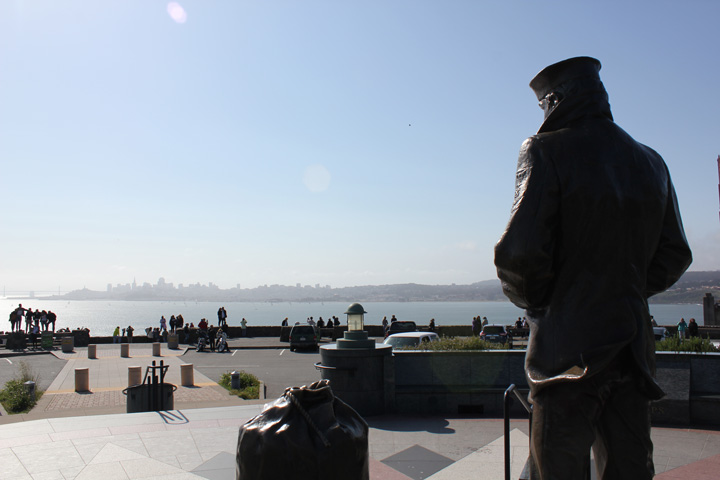
A replica of the Lone Sailor statue, on the Sausalito side of the bridge.
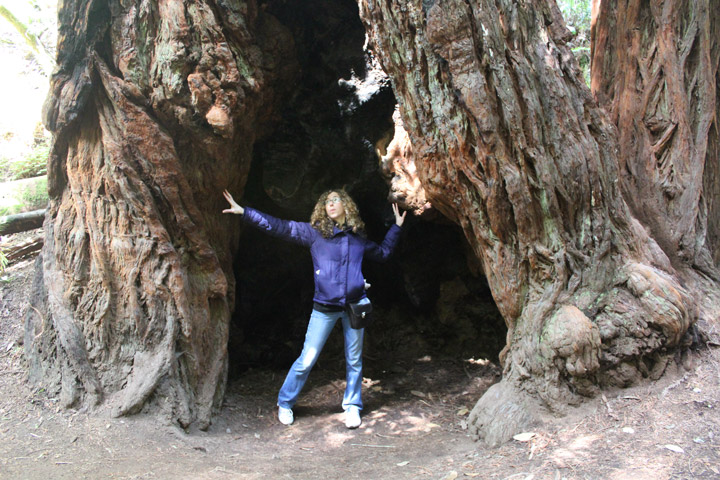
Checking out enormous trees at Muir Woods.
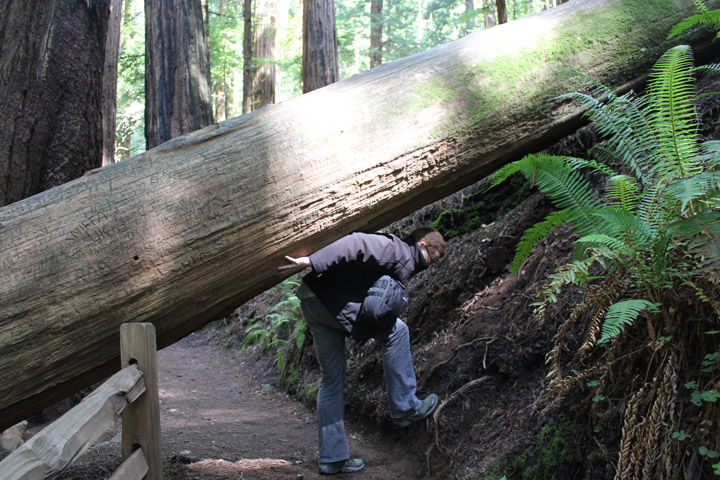
Amazing feats of strength! Muir Woods National Monument.
It was a little early for that, so we just drove over it. On the Marin County side, we stopped at a busy observation point; there were excellent views of the city, the bay, and European tourists. The observation point includes a statue of the Lone Sailor, the enduring recruitment symbol that has attracted dangerous loners and drifters to the Navy for many decades. This meant a great deal to me, as my own father had served in the Navy in the late 1960s and trained in San Francisco. He wasn't all that lone, what with the many loose women roaming the city. But they can't really make a statue for that.
Like my father before us, we kept driving north to see the crown jewel of Marin County. Whereas my father would have considered that to be the turtle races as Sausalito, we had a different crown jewel in mind. Muir Woods National Monument is one of the oldest institutions in the National Park Service; for more than 100 years, Americans have been enthralled by the idea of ****ing huge trees. A congressman named William Kent bought a valley with the hope of protecting a cluster of giant redwoods. In 1908, he figured the easiest way to preserve them was to entrust them to our nation's first manic president. Using the powers vested in him by the Antiquities Act, Teddy Roosevelt turned Kent's land donation into federal trees. They named the monument after John Muir, the founder of the Sierra Club.
We now live in an era of pornography on demand, and most Americans have ready access to monster truck rallies. Despite these facts, big trees are still a popular entertainment choice. Road signs told us the parking lot was already full, so we hopped on a shuttle bus to take us along the last 35 minutes of winding roads. As we walked through the gates (for free, as it was National Park Week), we were quite suddenly surrounded by some of the oldest and largest living organisms on the planet.
They were not quite as entertaining as a monster truck rally, or pornography on demand. But they were big enough to make an impression. The main trail takes you first to the most stunning feature of Muir Woods: the gift shop and bathrooms. There are numerous chainsaw sculptures of bears there, which greatly pleased my wife.
Amazingly enough, there's more! Walking along a stream, you're surrounded by redwoods, ferns, and whatever animals aren't scared off by several thousand tourists of varying ethnicities. The trees aren't anywhere near the size of a giant sequoia -- you can't drive through any of them -- but they are impressive nonetheless. There's a grove where, in 1945, the delegates forming the United Nations met to pay tribute to Franklin Roosevelt. This meant very little to FDR, as he had just died. But it was enough of a gesture to merit signage at a national monument.
We wandered off on a side trail for a bit. We saw some banana slugs, the majestic gastropods of the West. We took pictures of each other doing strange things with large trees. We learned very little about ecosystems or the symbiotic relationships that stave off death in our increasingly fragile planet. But that was admittedly a personal choice. It was a good couple of hours.
And on our way out, we appreciated the virtues of jet lag -- all the late risers were stacked up at the shuttle bus parking lot, facing hours of waiting. It's nice to appreciate nature in all its glory; it's even nicer to do so while feeling like a self-satisfied d-bag. Just like Teddy Roosevelt would have wanted.
Self-satisfaction burns a lot of calories, so it was time for a late lunch. Before voyaging to California, we used Facebook as our concierge; it doesn't wear a suit and call you sir, but it produces restaurant recommendations for a lot less than $300 a night. A person I once worked with revealed "the three best taquerias in San Francisco." In accordance with California law, I had to have a burrito for lunch, so it seemed like a good time to put that boast to the test. We instructed our GPS system to find Taqueria Can-Cun.
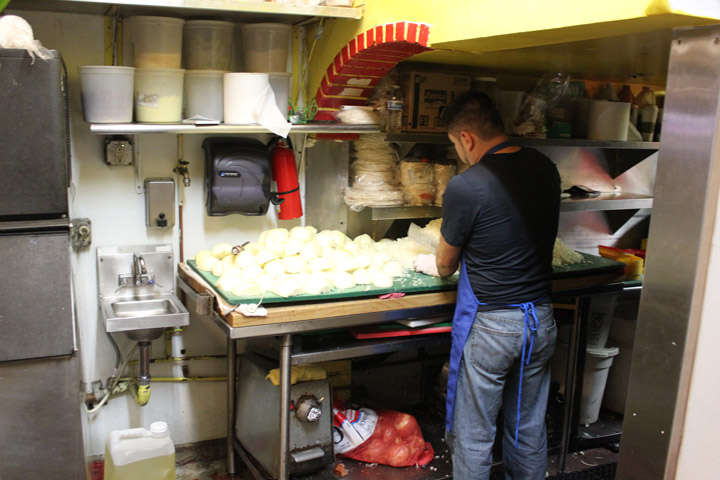
A staggering onion-chopping operation at a taqueria.
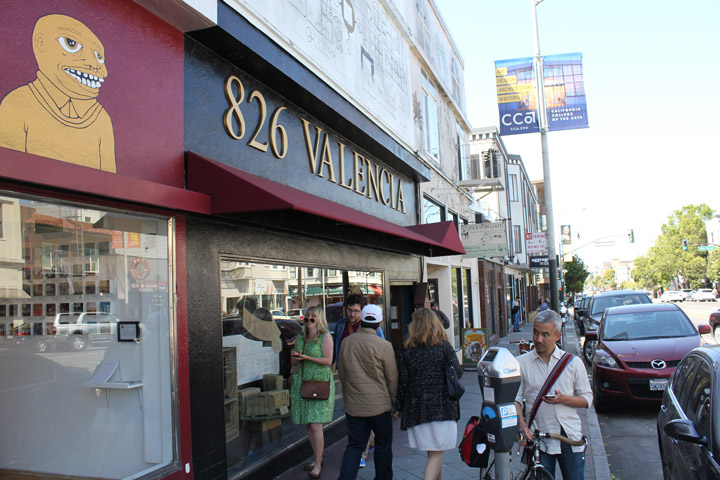
The hipster cool operation at 826 Valencia.

Ready to get weird at Haight-Ashbury.
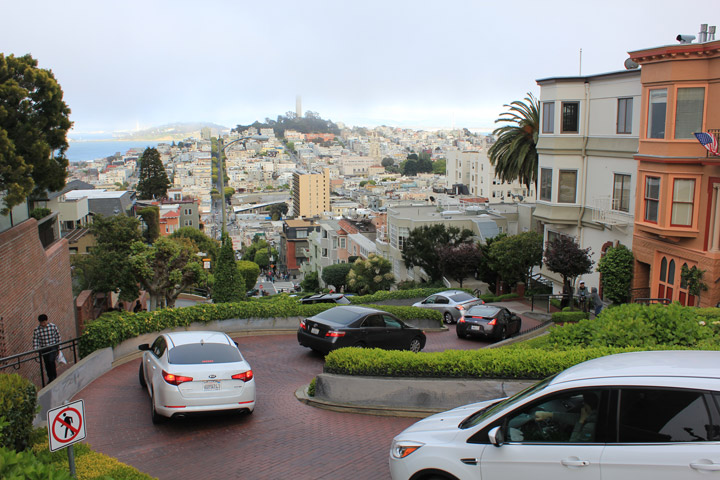
The iconic congestion of Lombard Street.
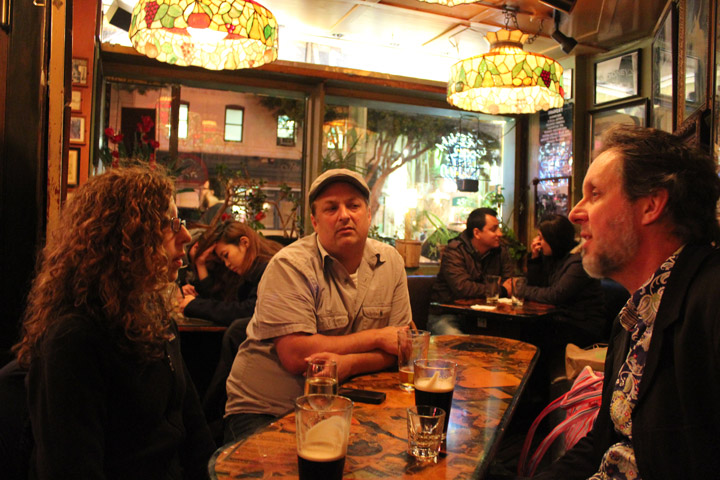
Chatting with the talent after the show at the Punchline.
Getting there is half the fun. A quick word on San Francisco streets. You have heard that they are hilly. This is a slight understatement. The city is on a peninsula, and there are two mini-mountains in the middle; there are also highlands along the coast to the north. After carefully weighing these realities, city planners decided that the best street system would be a rigid north-south grid that largely ignores topography. That way, you can have the maximum number of roads that most people would not walk up without a Sherpa.
When you're driving uphill, you usually have to stop at intersections where a direct breeze might flip your car backwards. When you're driving downhill, the slope is so steep that you cannot see the actual roadway beyond the intersection. Also, there are streetcars, which are not quite as charming when you're in a rental car, squeezed into traffic by a passing trolley and wondering if your insurance will cover the deaths of 15 Asian tourists. Bendy was at least an automatic -- if you can successfully drive a manual transmission car around San Francisco, it should be legal for you to drive through any other city while high on crystal meth.
Regardless, we made it. You could tell Taqueria Can-Cun was fun, because most of the decorations seemed straight from the Cinco de Mayo display at your local party store. You could tell it was good because of the onion guy. Standing on one side of the counter, he was using an enormous knife to continuously chop onions. Which is to say, he had a pile of chopped onions that was about a foot high and three feet long, and he wasn't crying, because his body is probably immune at this point. You could tell it was authentic, because you could order brains or tripe for your burrito. As a nice bonus, some guy wandered in off the street with a guitar, singing in Spanish and standing over tables in hopes of a tip. This is a terrible business model if you aren't brandishing a weapon, and no one gave him a tip. But we appreciated the show.
One delicious chorizo burrito later, it was time to put our afternoon plan in motion: We were going to see what San Francisco is all about. Some people say that you can't truly know a city without living there for a few months, experiencing its many subcultures, participating in community celebrations and soaking in the ethic of its people. Other people say that you can get the gist by visiting a few neighborhoods mentioned in a guidebook and buying either a t-shirt or frozen yogurt from a non-chain establishment. If my mom taught me anything, it's that some people are jerks, and who am I to judge other people?
As it turned out, our trip to the taqueria had already brought us to The Mission, a neighborhood known for being known for things. It used to be mostly church property. Then it was a barrio, then it was home to punk rockers, then it was home to more Central American immigrants. The area we explored on Valencia Street was a showcase for the newest wave: hipsters.
Aspiring hipster writers know all about McSweeney's -- it's a publishing concern run by David Eggers, and everything they print is supposed to be terribly profound or hopelessly silly. Most of what they produce is too cute by three-quarters, and yes, that includes everything I wrote for them. They have writing centers around the country, but the flagship is 826 Valencia; the front of the building is operated as a pirate supply shop. (They gloss over the murder and rape, so take your kids.)
It was interesting, but not invigorating. It felt like San Francisco lite, and we wanted the version that was smothered in chocolate sauce. Before there were hipsters, there were hippies. San Francisco is where they lived, and Haight-Ashbury was their mothership. So we hopped back in the car and went there.
We parked on the edge of Buena Vista Park, on the eastern side of the neighborhood. "Buena vista" means good view, which refers to the fact that you must drive up streets with a 53 percent grade to get there. The park itself is a delightful bit of wilderness with some paved trails. It seems like the perfect place to smoke an industrial-size bag of weed and go for a walk with your unleashed mastiff.
We had neither of those things with us, so we proceeded to the main drag. Block after block, there's a throng of people on the sidewalks. We popped into a vintage clothing store with outfits from the 1880s and a few quirky t-shirt shops. At the end of the line, there's an Amoeba Records; it was the first-largest second-hand music store I've ever seen. We were there on Record Store Day, which is apparently a big deal if you wear a lot of black, have a wispy moustache and incorporate at least one chain into your outfit every day. We loaded up on CDs for the car. There was a DJ spinning in the corner. There were people walking their dogs through the store, and many of those dogs had styled hair or ridiculous outfits. The whole thing felt crunchy. This was the San Francisco we were looking for.
The only thing missing from the Haight-Ashbury experience, unfortunately, was the hippies. The Summer of Love was in 1967, so even the youngest of the original hippies would be pushing 70. It's not a lifestyle that ages well -- ponytails and poor personal hygiene get less endearing on most people once they pass 50 -- and the new recruits aren't good for public relations. They are young, they smell, and they panhandle really aggressively. They are unemployed by choice -- they are not disabled, or starving, or incapable of learning to work an espresso machine. And they have exactly no shame. You expect a disassociative guy with no shirt and a rope belt to yell at you for not giving him change, but it's a little shocking when you get the same treatment from a fully-dressed white kid in good health. If you want any realistic shot at money, you need to offer a service, like fighting for the country in a southeast Asian jungle or serenading people as they eat their brain burritos.
Allyson asked me what it meant to be a hippie these days, and I couldn't venture a guess beyond "not liking work." Say what you want about the flower children, but at least they believed in something: endless amounts of recreational sex with a wide variety of partners, while high on drugs.
If there's a tourism lesson here, it's this: people will disappoint you, so put your faith in infrastructure. On bidding farewell to Haight-Ashbury, we headed back toward the hotel via Lombard Street to see the CURVIEST STREET IN THE WORLD!
Allegedly. Lombard Street is a nice, straight road for most of its length, but one stretch stymied even San Francisco's city planners. They needed to give one residential block either an 87 percent grade, or seven or so switchbacks. Either choice would have made for an excellent tourist attraction, but they chose the curves.
People actually queue up for that kind of fun. As we approached from the west we could see the two-block backup of people waiting to drive very slowly downhill. Rather than join them, we took a detour to the bottom of the hill, where we were able to park and walk up the windy sidewalk. This is a perfectly legitimate way to experience Lombard Street; you get better photo opportunities, and you can look directly at the faces of the many motorists who are realizing that they just waited 30 minutes to once again experience the thrill of a driving test. Only if you fail, you crash into somebody's home!
The short and winding road brought us to our evening plans. Allyson works for a comedy club, and I used to perform professionally as a stand-up. You go on vacation to get away from work -- but our hotel was in walking distance of a club, and we happened to know the headliner for the evening. It was time to enjoy one of the truly elegant and beautiful things about working in the entertainment industry: Simply by going out to enjoy some nightlife, we could justify writing off the full cost of our trip as a business expense. Probably. We'll see what the judge says.
After chilling out at the Palace for a bit, we went back to The Grove, for the sake of convenience. It was a short stroll along thankfully level streets to the San Francisco Punchline. It's a classic comedy club, in the best sense -- the ceilings are low, it seats less than 300, and every table is fairly close to the stage. There aren't any bells or whistles. Our emcee was a guy named Paco Romane. The feature act was Clinton Jackson. And the headliner was Jake Johannsen. Jake has been on Letterman about 4,000 times, he constantly changes his act, and he is a stunningly good performer. He should be more famous than he is, and I strongly encourage you to, at the very least, mail him money for no particular reason.
Afterward, in the interest of making our tax deduction airtight, Jake and Paco took us to Vesuvio, a bar where the Beat poets used to hang out. It was across the street from The Condor, where Carol Doda used to perform. We walked home past the Transamerica Pyramid. Somewhere in there we hit the day's quota for San Francisco stereotypes. At that point it was 2 a.m.
And that's why jet lag is your worst enemy. Our bodies thought it was 5 a.m., the hour at which I usually wake up to pee before going back to bed. My body was also digesting two burritos, which is tough in any time zone. We crawled back to the Palace and the ghost of Warren Harding, to get a few hours of sleep before our vacation had to continue.
It takes a lot of work to relax the Chris White way.
